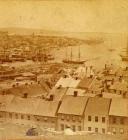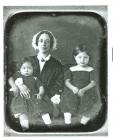1
I love Canada because . . .31 May 2008
Queens County, New Brunswick, Canada
 Credits:
Credits:Courtesy of Allie, Triangle 4-H Club
2
As the 1860s began New Brunswick was experiencing an economic boom. Logging, lumbering, fishing, shipbuilding, shipping and agricultural industries were thriving and the port of Saint John was the economic and trading center of the Maritimes.3
Stereograph detail: View of Saint John Harbour from Fort Howe, Saint John, New Brunswickc. 1875
Saint John, New Brunswick, Canada
 Credits:
Credits:Gift of Margaret Whelly, 1922
New Brunswick Museum
4
Politically, the 1860s began with some storm clouds on the horizon. South of the border, the United States was on the verge of Civil War. Some in the Maritimes were thinking of union of the eastern provinces. In Upper Canada, others were thinking and talking of a broader union. All were thinking of ways to take more control of local affairs away from the colonial and imperial officials that had ruled since the time of the Loyalists. It was in this climate that the Queen's eldest son, Albert, Prince of Wales, visited North America. This plate is from a large service that was used to serve the Prince of Wales during his visit to Government House, Fredericton.5
Dinner plate used to serve HRH The Prince of Wales, 18601858
London, England
 Credits:
Credits:Gift of Russel Bond, 1998
Queens County Historical Society & Museum Inc.
6
As Provincial Secretary, Samuel Leonard Tilley was privy to the swirl of political chatter about union. He recognized the potential of acting with one voice when it came to dealing with the imperial powers of Britiain and he also approved of the notion of democratic reforms that would put more control in the hands of the people through elected representatives. When war finally erupted in the United States, the concern of security was added to the list of advantages of provincial union. Would an army on the march in America stop when the rebellion in the southern states was quelled? The prosperous provinces of British North America with their thriving economies and vast natural resources were very attractive.In 1861, Charles Fisher was removed from government and Samuel Leonard Tilley became head of his party and the modern day equivalent of premier of the province.
7
Photograph: Samuel Leonard Tilleyc. 1865
Saint John, New Brunswick, Canada
 Credits:
Credits:Walter Ranton Starkie Memorial Collection, gift of Villah A. Starkie
New Brunswick Museum
8
Political success for Tilley soon paled and became secondary to concerns at home. In an age when illness and death were swift and indiscriminate, Tilley suffered a severe blow when his dear wife Julia died in March 1862, apparently of cancer. Friends advised hard work and devotion to a cause to cure his understandably melancholy mood. It seems Tilley took this advice as he embarked on the dream of confederation in the coming years.9
Photograph: Julia Hanford Tilley and her daughters, Annie and Louisac. 1850
Saint John, New Brunswick, Canada
 Credits:
Credits:Courtesy of the National Archives of Canada, 2001
Queens County Historical Society & Museum Inc.
10
Samuel Leonard Tilley had no great interest in the union of New Brunswick, Nova Scotia and Prince Edward Island, known as Maritime Union. He was much more interested in a larger project, the union of all the provinces of British North America. Tilley envisioned railways crossing the provinces and tracking westward to the vast untapped resources of Quebec, Ontario and even further west. Wealth would flow eastward to New Brunswick and the major port of Saint John. By 1863 Tilley was in contact with representatives in Ontario, then known as Upper Canada, discussing a broader union of the provinces. When John A. Macdonald obtained control in Canada, the way was clear for official discussion.12
In the summer of 1864, representatives from New Brunswick, Nova Scotia, Prince Edward Island and Canada met at Charlottetown to discuss intercolonial matters with an aim toward establishing an official union of the provinces. The notions of speaking with one voice with Britain, sharing the wealth and providing a unified secure front to the growing military power of the United States figured prominently in these early stages of discussion.13
Photograph: Confederation and British Connection1866
Saint John, New Brunswick, Canada
 Credits:
Credits:New Brunswick Museum
